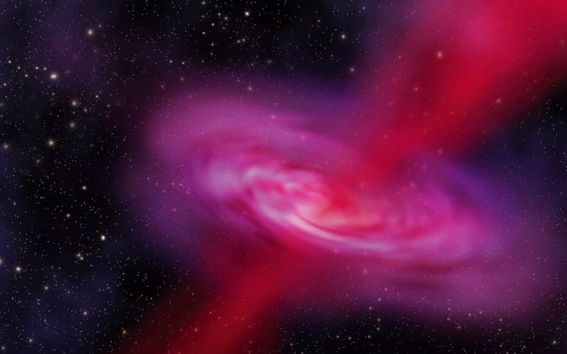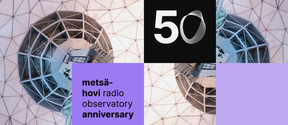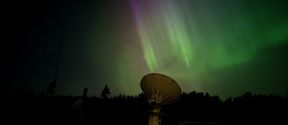Radio astronomy takes you on an expedition to space

Anne Lähteenmäki works as a Professor of Radio Astronomy at Aalto University's Metsähovi Radio Observatory, and at the Department of Electronics and Nanoengineering. Lähteenmäki’s professorship is the only one of its kind in Finland.
Located in Kirkkonummi, also Metsähovi is a unique facility. It houses the only telescopes of radio astronomy research in Finland, used around the clock, every day of the year. The largest one is 13.7 metres in diameter, and its surface accuracy is suited for millimetre-scale observations.
Galaxies, quasars and solar storms
Lähteenmäki studies, among other things, radiation of objects in space, such as active galaxies. Her recent research has focused particularly on less well-known young galaxies. For example, signals sent by these galaxies and their variations are studied at Metsähovi.
Metsähovi Radio Observatory enables frequent and long-term observations. Observations on distant active galaxies and their brightest special cases, quasars, have been made at Metsähovi for decades. Long-term research has indicated that young galaxies previously deemed as silent on the basis of individual findings, actually send a lot more radiation to space than expected. This discovery challenges the existing theories on how galaxies are formed, and on their growth from faint and modest galaxies to bright quasars.
Observations on the Sun have been made at Metsähovi for 41 years already. By studying the sun, researchers learn to understand more about, for instance, the birth and development of solar storms. Solar storms cause massive disruptions on Earth's positioning and transmission systems. The waiting period between a storm being noticed and its impact on Earth is two days. Through more accurate research, the development and direction of a storm could be better anticipated. This way, the waiting period could be extended to as much as a fortnight.
A coherent whole is constructed from pieces
As Lähteenmäki studies the radiation of space objects within the entire electromagnetic spectrum ranging from radio waves to gamma radiation, international research cooperation is essential.
Observations made at Metsähovi’s radio wavelengths are combined with data from different wavelengths produced by observatories and satellites in different countries. The combination of data produces a coherent whole, which can be used for testing and verifying models created by researchers on the operation of active galaxies, and for developing new and better models.
Observations can be used to study the characteristics of young, active galaxies, for example, plasma jets that emit radio waves and sometimes also gamma radiation. Plasma jets stem from the vicinity of each galaxy’s supermassive black hole and move at nearly the speed of light. Research also contributes to a better understanding of the characteristics and evolution of black holes.
Technology supports the discovery of something new
The strengths of Metsähovi Radio Observatory are frequent series of observations spanning over long periods of time, and a less common observing frequency.
Researchers also have plenty of observation time at their disposal, which is a significant advantage in international projects. The research group has access to the entire observatory, and in the summer, for example, the Sun can be monitored for as long as 16 hours a day.
As technology advances, it is crucial to update Metsähovi’s equipment. In autumn 2019, Aalto University launches a fundraising campaign for purchasing a new receiver for the observatory. Among other things, the new device would enable three times more accurate observations.
For Anne Lähteenmäki and her research group, this would mean access to tools using the latest technology, which would help the researchers see further and deeper into the core of even the faint active galaxies.
More information on the upcoming fundraising:
Elina Karvonen
Donor Engagement Manager
+358 503641446
[email protected]
More on Anne Lähteenmäki's research on the video

Metsähovi radio observatory's 50th anniversary - check out pictures of the event
Aalto University's Metsähovi radio observatory turns 50 this year. On Observatory's birthday, Thursday 11. April, guests gathered together to celebrate the past decades and the development of radio astronomy in Finland.
Congratulations to the 50 year old Metsähovi Radio Observatory
Exactly 50 years ago on April 11, 1974, the radio telescope in Kirkkonummi moved for the first time, and since then it has gathered data from outer space 24 hours a day, 365 days a year.
Metsähovi Radio Observatory turns 50 and gets new telescopes
Students helped design and build the new telescopes, which expands the opportunities for multidisciplinary space research and education
Tähtitiistait event series in autumn 2024
Aalto University's Metsähovi radio observatory turns 50 this year. To mark the anniversary, an open lecture series "Tähtitiistait" will be held in the new Marsio building in autumn 2024. Welcome!- Published:
- Updated: